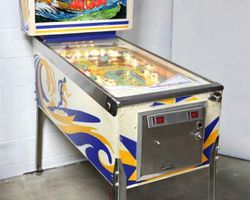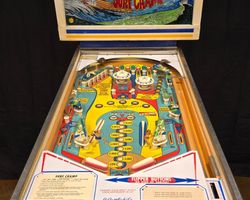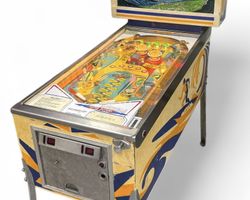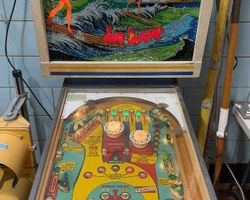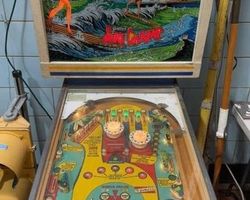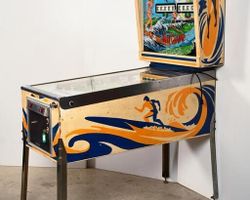Surf Champ
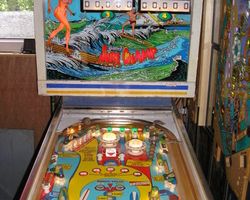
Average Prices: USD $300 to $1,200
Produced: August, 1976
Production Run: 10,070 units
Machine Type: Electro-mechanical
Players: 4
Design by: Ed Krynski
Art by: Gordon Morison
Surf Champ, an electro-mechanical (EM) pinball machine from D. Gottlieb & Co., emerged in August 1976, capturing the vibrant spirit of its era. This four-player machine, known for its distinctive surf theme, was a significant release for Gottlieb, showcasing their enduring commitment to innovative EM design as the industry began its transition towards solid-state technology. The inspiration for Surf Champ was rooted in the widespread appeal of beach culture, sports, and recreation, themes that Gottlieb frequently explored to resonate with a broad audience.
The machine's creation involved key figures in Gottlieb's design team. Ed Krynski, a prolific designer for the company, crafted the playfield layout and gameplay mechanics. Krynski's work during this period was characterized by intricate playfields that balanced challenge with accessibility, often incorporating novel shot opportunities. The visual identity of Surf Champ was brought to life by Gordon Morison, Gottlieb's long-standing artist. Morison's artwork for the machine, with its depictions of surfers, crashing waves, and bright, sun-drenched beaches, perfectly encapsulated the theme, contributing significantly to its overall charm and appeal.
Surf Champ entered the market with a considerable production run, initially reported at 1,070 units. However, subsequent detailed company documentation revealed a much larger confirmed production of 10,343 units, including 273 sample games. This corrected figure highlights Surf Champ's substantial presence in arcades and amusement locations of the late 1970s. This production volume, combined with its timing, positioned Surf Champ as one of Gottlieb's more widely distributed and played EM titles as the industry approached the solid-state revolution. Its two-player counterpart, Surfer, released in the same year, shared the same core design but with a simplified scoring scheme for two players, making Surf Champ the more feature-rich and complex offering.
Signature Features and Design
Surf Champ’s design is a testament to Gottlieb’s prowess in EM pinball, integrating several standout features that define its gameplay and aesthetic. The playfield is adorned with colorful artwork by Gordon Morison, depicting surfers riding waves, beach scenes, and a generally upbeat, recreational atmosphere. This artistic style, typical of Gottlieb’s mid-70s machines, contributes to the machine's inviting appearance, characterized by its bright blues, yellows, and oranges, all bathed in the warm glow of incandescent lighting.
Central to the gameplay experience are the five-bank drop targets positioned across the upper playfield. These targets are a primary objective, demanding precise shots to clear. Another defining feature is the spinning target, situated in a somewhat challenging location on the upper playfield. Its spinning action adds an element of unpredictability and kinetic energy to the game. Two pop bumpers activate with satisfying force, propelling the ball around the upper area, while slingshots flank the outlanes, providing dynamic rebounds. The machine also incorporates five star rollovers, crucial for activating bonus multipliers, and a kick-out hole that collects the ball and awards points, often returning it to a flipper for another shot. The sound design relies on a system of three chimes, providing auditory feedback for scoring events and bonuses, a characteristic element of EM machines that offers a rhythmic, mechanical soundtrack to the gameplay. These features collectively create a dynamic and visually engaging playfield that encourages players to explore various shot types and strategies.
Playfield and Mechanics
The Surf Champ playfield is meticulously laid out to offer a range of shot opportunities and strategic depth. The lower portion features two standard flippers and two slingshots, leading to a center drain and outlanes on either side. Above the flippers, a clear shot up the center leads to the five-bank drop targets. These targets, when cleared, award points and often activate other features. Flanking the drop targets are lanes that lead to the upper playfield, where the two pop bumpers are situated. These bumpers serve to randomize ball movement, making shots to the upper targets more challenging.
A key element of the playfield is the spinning target, located in the upper-right section. This target, when struck, offers points and activates a satisfying spinning motion. Strategically, hitting it can be challenging, often requiring a precise bank shot or a carefully timed direct hit. Five star rollovers are distributed across the playfield, some in lanes and others as standalone targets. Completing these rollovers is integral to building the end-of-ball bonus and multiplying its value. A kick-out hole in the upper-left corner collects the ball after certain achievements or successful shots, then ejects it back into play. The design philosophy behind this layout emphasizes a combination of direct, skill-based shots towards the drop targets and rollovers, coupled with the unpredictable deflections from the pop bumpers and spinner. The layout is not strictly symmetrical, which adds to its unique character and requires players to adapt their strategies based on the ball's position. The overall aesthetic of the playfield, with its bright, surf-themed artwork and simple, clear lighting, complements the mechanical action, drawing the player into the laid-back yet competitive world of beach sports.
Gameplay Dynamics
Surf Champ’s gameplay dynamics offer a compelling blend of accessible mechanics and surprising strategic depth, particularly for an EM machine from its era. The primary objective revolves around accumulating points and completing specific goals to maximize the end-of-ball bonus. Players earn points by hitting targets, rollovers, and the spinner, with the maximum displayed score reaching 99,990 points per player.
The five-bank drop targets are central to scoring and progression. Clearing all five targets awards a significant point bonus and typically resets the targets, allowing players to repeat the objective. The spinning target also contributes to scoring, though its value can vary depending on whether it is lit. A key strategic element involves the five star rollovers. Completing these rollovers progresses the end-of-ball bonus multiplier, which can go up to triple bonus on the final ball. This bonus system encourages players to work towards clearing these rollovers throughout the game, as their accumulated value is paid out at the end of each ball, with a substantial multiplier applied to the last ball.
Surf Champ offers distinct rule sets depending on whether the machine is configured for 3-ball or 5-ball play, adding a layer of strategic variation. For instance, in a 3-ball game, the pressure to maximize bonus multipliers on the final ball becomes more intense, leading to different risk-reward considerations compared to a 5-ball game. The kick-out hole often serves as a reward for hitting certain targets or making specific lane shots, contributing to the overall score and returning the ball to a playable position. Player strategies often involve aiming for the drop targets, then focusing on the star rollovers to build the bonus multiplier. However, the placement of the spinner and the pop bumpers can make these shots challenging, requiring players to master bank shots or develop precise flipper control. The game rewards patience and accuracy over frantic play, though the random nature of EM ball physics ensures that no two games are exactly alike. The constant pursuit of the next bonus multiplier or the satisfaction of clearing the drop targets provides a captivating gameplay loop that encourages repeat plays.
Reception and Legacy
Surf Champ has garnered a generally positive reception within the pinball community, with many enthusiasts considering it a well-designed EM title from its period. Its strengths are frequently cited as its engaging gameplay, which often elicits a "one more game" reaction from players. The machine's variety of features, including the drop targets, star rollovers, spinner, and kick-out hole, contribute to a diverse and satisfying gameplay experience. Players particularly appreciate the depth of its ruleset, especially the integration of the bonus system, where completing rollover stars for bonus multipliers on the final ball introduces a key strategic layer. The artwork and surf theme are widely praised for being bright, colorful, and representative of the era, contributing to the machine’s overall appeal. Many find Surf Champ accessible for new players while offering enough challenge and nuance to keep experienced players invested.
However, Surf Champ is not without its criticisms. A significant point of contention revolves around the perceived difficulty of certain shots, which some players find frustrating. The top drop targets are frequently mentioned as challenging to hit directly, often requiring risky bank shots or backhand flipper work. The placement of the spinner is also a common point of discussion; while a feature, some find its location problematic, as direct hits can sometimes lead to the ball draining down the center. This contributes to the machine being characterized as a "drain monster" by some, where many shots carry inherent risk. A minority of feedback has also suggested that the artwork, while colorful, is less distinctive than some of Gottlieb’s earlier 1960s titles. Despite these criticisms, Surf Champ’s legacy is strong. It stands as a notable example of Gottlieb’s EM prowess in the late 1970s, demonstrating how complex rules and engaging play could be achieved without solid-state electronics. Its continued appeal lies in its blend of classic pinball mechanics with a strategic scoring system, securing its place as a machine that offers enduring replayability for those who appreciate the unique feel and challenge of an electro-mechanical game.
Sponsored Links
 Ebay Listings
Ebay Listings
 Auction Results
Auction Results
| Cost | Location | Date |
|---|---|---|
| USD $1,500 |  Missouri, United States Missouri, United States |
01 December, 2025 |
| USD $500 |  California, United States California, United States |
31 August, 2025 |
| USD $4,495 |  California, United States California, United States |
17 August, 2025 |
| USD $800 |  Maryland, United States Maryland, United States |
04 May, 2025 |
| USD $944 |  Maryland, United States Maryland, United States |
04 May, 2025 |
| USD $2,900 |  Minnesota, United States Minnesota, United States |
05 February, 2025 |
| USD $2,900 |  Minnesota, United States Minnesota, United States |
05 February, 2025 |
| USD $550 |  Illinois, United States Illinois, United States |
17 November, 2024 |
| USD $900 |  Pennsylvania, United States Pennsylvania, United States |
06 July, 2024 |
| CAD $625 |  Canada Canada |
02 December, 2023 |


Private Policy · Search Website · Contact Us
As an eBay Partner, we may earn a commission from qualifying purchases made through links on this site, at no additional cost to you.
All trademarks and copyrighted materials remain property of their respective owners. All other content copyright 2007 - 2025 Pinpedia.

